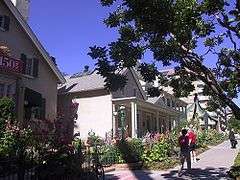Brigham Young Complex
|
Brigham Young Complex | |
|
Photograph of the Lion House from the sidewalk, with the Beehive House just visible behind | |
 | |
| Coordinates | 40°46′11.2″N 111°53′19.6″W / 40.769778°N 111.888778°WCoordinates: 40°46′11.2″N 111°53′19.6″W / 40.769778°N 111.888778°W |
|---|---|
| Built | 1855 |
| Architect | Angell,Truman O.; Ward,William |
| Architectural style | Classical Revival, Late Gothic Revival |
| NRHP Reference # | 66000739, 70000626 |
| Significant dates | |
| Added to NRHP | October 15, 1966[1] |
| Designated NHLD | January 28, 1964[2] |
The Brigham Young Complex is the collective name given in the U.S. National Historic Landmark program to a set of two houses in Salt Lake City, Utah. These houses were the residence of Brigham Young from 1852 until his death in 1877. As President of The Church of Jesus Christ of Latter-day Saints at the time of the Mormon settlement of the Salt Lake Valley, Young and his home were pivotal in the development of the Church, Utah, and the American west. The houses were designated as a National Historic Landmark in 1964.[2]
The two houses that make up the Brigham Young Complex are:
- The Beehive House
- The Lion House
See also
References
- ↑ National Park Service (April 15, 2008). "National Register Information System". National Register of Historic Places. National Park Service.
- 1 2 National Park Service. "National Historic Landmarks Program: Database of National Historic Landmarks". Retrieved March 11, 2015.
External links
![]() Media related to Brigham Young Complex at Wikimedia Commons
Media related to Brigham Young Complex at Wikimedia Commons
This article is issued from Wikipedia - version of the 11/25/2016. The text is available under the Creative Commons Attribution/Share Alike but additional terms may apply for the media files.
